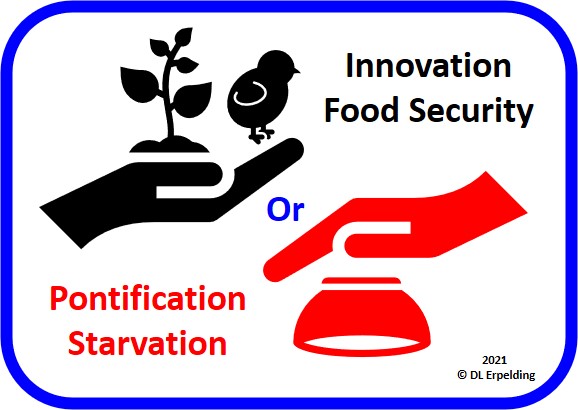UN Food Systems Summit: Innovation and food security or pontification and starvation?
Need to act through the lens of the starving, not pontificate through the lens of the affluent!
June 8, 2021

A choice for the forthcoming UN Food Systems Summit, do we endeavor to feed all or starve millions? Does the summit lead to actions that ensure food security? Or does the summit lead to pontificating about transformations that yield further malnourishment? Food security needs and planetary boundary limits necessitate that we all act in a ‘One Health’ globally collaborative manner. Every individual, company, entity, and government has a role to play in achieving food security for all globally. The science is certain that food insecurity is rising, and that the climate is changing. Scientifically, reasoned individuals may debate and ponder the extent of both, and exact causes of both, yet we need to act now to meet the food needs of all and to protect our planet. Experiences would indicate there is a path forward to feed all now, but current mindsets, policies, and practices need to change for success. We need to leverage our learnings from past decades, be open to ideas from all for improvement, and ultimately ensure we meet the nutritional needs of the neediest now and in the future.
Undernourished: Today 7.8 billion individuals need a food source each day, ideally ones providing nutritious balanced meals. The “2020 The State of Food Security and Nutrition in the World – Transforming Food Systems for Affordable Healthy Diets” report notes “… almost 690 million people in the world (8.9 percent of the world population) are estimated to have been undernourished in 2019.” It is widely anticipated that due to the COVID-19 pandemic impact hundreds of millions of individuals will be added to the undernourished list globally. Based on personal insight, the COVID-19 impact is real in developing country areas, the ability to afford rice, eggs, meat, or milk, is diminishing beyond the financial means of far too many today.
Amplifying the urgent need to get our food system right, a May 2021 report, “Global Report on Food Crises”, notes 155 million people are in a ‘crisis’ or worse status in 2020, nearly 20 million higher than in 2019 (worse status being ‘emergency’ and “catastrophe / famine). This 15% increase is “… driven by persistent conflict, pre-existing and COVID-19-related economic shocks, and weather extremes.”
Reality lens: In acting to transform the global food systems, when viewing through the lens of the undernourished, affordability and availability our key. Aspects of safety and nutrition are important, but only once one has food to eat. Aspects of choices around production practices such as organic, natural, regenerative, and conventional are far beyond the realm of the most vulnerable. Selecting whether a plant-based or animal-based food source, is a luxury of choice beyond the scope for the poorest. The lens of reality needs to drive our future global food systems, recognizing that the undernourished trend the past five years is going the wrong direction, thus affirming the need for modification of current actions yielding failure, and learning from past actions that yielded success.
The summit: The UN Food Systems Summit is considering policy ideas in the areas of nutrition and health, the environment, and economics that can help achieve the United Nations Sustainable Development Goals (UN SDGs). The UN Food Systems Summit has five action tracks including: 1) ensuring access to safe and nutritious food for all, 2) shifting to sustainable consumption patterns, 3) boosting nature-positive production at scale, 4) advancing equitable livelihoods, and 5) building resilience to vulnerabilities, shocks, and stresses.
Action track actions: Actions need to consider the enormous challenges of feeding the over 690 million undernourished today and the estimated future population growth of billions. Actions need to leverage the tremendous opportunities availed through innovation that increase availability and improve affordability. Outlined below are key ideas where the agriculture production sector and the whole global food systems can collaborate to advance research, innovation, and its adoption that will help achieve the 2030 SDGs. Ideas offered are built around each of the Summit action tracks.
Action Track 1 - ensuring access to safe and nutritious food for all à will work to end hunger and all forms of malnutrition and reduce the incidence of non-communicable disease, enabling all people to be nourished and healthy:
Support global food trade based upon scientific principles so that consumers globally have access to safe and nutrient rich foods, plant- and animal-based. Open trade is recognized to improve food supplies at a more affordable price and provide more variety of food choices.
Build infrastructure and cold chain systems that will increase the availability and support the preservation of fresh food products – meat, dairy, vegetables, and fruit; especially adapting such systems to meet needs in the least developed areas where local wet markets are key food supply sources. Notably, better cold chain systems can dramatically reduce the globally estimated food waste of up to 40%.
Engage Codex to advance food safety standards and guidance, and OIE (World Organization for Animal Health) to adopt animal disease standards, so governments, the private sector, and consumers have science-based food safety and animal diseases reference points to ensure animal health and food safety.
Action Track 2 - shifting to sustainable consumption patterns à will work to build consumer demand for sustainably produced food, strengthen local value chains, improve nutrition, and promote the reuse and recycling of food resources, especially among the most vulnerable:
Support consumption of diversified nutritious diets that include dairy, meats, aquaculture, eggs, grains, vegetables, and fruits. Varying by country, livestock supplies up to 48% of protein for human diets.
Leverage non-human edible food sources. About 86% of livestock feed such as grass, fodder, and crop residues, is not suitable for human consumption. Ruminants upcycle by grazing marginal lands and consuming crop byproducts turning such into foods, milk and meat, that are nutrient dense foods rich in vitamins and minerals. Focusing on more efficient upcycling will produce more food for many.
Support innovation in the developing world livestock systems. Globally, the average greenhouse gas emissions (GHGs), of the total GHSs, are estimated at 14.5% for livestock. However, such is misleading as it varies by country and species ranging from 1% to 14% or more, in part due to regional differences in production systems. Further ruminants such as cattle consume different diets than pigs or chickens. The developing world is estimated to produce about 80% of global livestock emission, in part due to the role of cattle in meat and milk production, but also due to efficiency differences.
Increasing efficiency of production, via improved genetics, nutrition and health management will result in decreased emission per unit of nutrient output. Improved plant yields and precision agriculture practices will meet human food and animal feed needs.
Action Track 3 - boosting nature-positive production at scale à will work to optimize environmental resource use in food production, processing, and distribution, thereby reducing biodiversity loss, pollution, water use, soil degradation and greenhouse gas emissions:
Recognize that both plant and animal production is very scalable globally ranging from backyard operations to major integrated operations. Improve linkages of supply chain segments to support scaling up while adapting locally.
Support best practice initiatives and knowledge transfer focused on biosecurity, genetic selection, disease resistance, nutrition, and health.
Build communication structures providing digital connectivity via satellites and mobile phones to support livelihoods in developing and developed countries. Provide access to information and education of farming best practices.
Understand value chain incentives and limitations. Recognize consumers in the least developed areas are the most price sensitive so align for them affordable production systems. Efficient conventional production systems have the smallest carbon footprint while yielding the lowest cost food supply chains.
Action Track 4 - advancing equitable livelihoods à will work to contribute to the elimination of poverty by promoting full and productive employment and decent work for all actors along the food value chain, reducing risks for the world’s poorest, enabling entrepreneurship and addressing the inequitable access to resources and distribution of value:
Encourage livestock production, including cattle, pigs, poultry, and aquaculture that can be initiated with relatively low initial investments. The livestock lifecycle varies from months to years and can be adapted to various climates providing families food, income, and livelihoods.
Support the engagement of small shareholders and women in animal production. Identify and adapt to local development needs by areas, for example poultry can start with dual purpose breeds for meat and eggs and evolve to more single purpose breeds for meat or eggs.
Action Track 5 - building resilience to vulnerabilities, shocks, and stresses - will work to ensure the continued functionality of sustainable food systems in areas that are prone to conflict or natural disasters … will also promote global action to protect food supplies from the impacts of pandemics:
Build sound biosecurity measures to avoid or minimize risks for zoonotic and transboundary diseases. Measures should be adapted to consider local, national, regional, and global risks and needs.
Adapt holistic farm production systems, animal and plant, starting with genetics and traits that withstand or minimize disease and climate risks.
Support global efforts for a strong domestic production sector while also working to ensure trade thereby resulting in resiliency so that the global system collectively provides access to animal and plant sourced food.
Together all the above can contribute to a more sustainable global food production system that will yield nutritious food, reduced carbon footprints, and enhanced livelihoods globally. These actions and policy measures will generate synergies that benefit smallholder farmers, leverage high-tech farming techniques, and support inclusive and more equitable production systems.
Agriculture innovation and adoption of best practices will be key to achieving the UN SDGs and food security globally. As we chart our path forward the vision includes three key parts: 1) food security via animal sourced and plant sourced foods that are affordable, nutritious, and rich in all core nutrients and micronutrients, 2) environmentally sensitive production via increased efficiency, reducing our carbon footprint, and protecting the diversity of nature, and 3) enhancing livelihoods via improving incomes, access to digital technology, and scalable practices.
Closing perspective, looking ahead to the UN Food Systems Summit, as the billionaires, and elite polluters, and well-fed pontificate in the days ahead about the great transformation needed in the global food systems, one might suggest let us all modify our view, and view the actions needed through the lens of the starving, the poorest. Dining in a 5-star restaurant is not an option for most, rather dining out under the stars is a reality for most. Jetting to a global food summit is not an option for most, rather walking to the local wet market is a reality for most. Let our focus for actions to improve our global food systems be through the lens of reality of the undernourished. Let us be sure not to deprive the neediest of the pleasures of the affluent.
The UN Food Systems Summit is our opportunity to support innovation and advance food security for all. It is our opportunity to build a more sustainable global food system, one that is economically strong, one living within the planetary boundaries, and one that yields a healthy and nutritious diet for all – a true ‘One Health’ world.
About the Author(s)
You May Also Like



.png?width=300&auto=webp&quality=80&disable=upscale)

